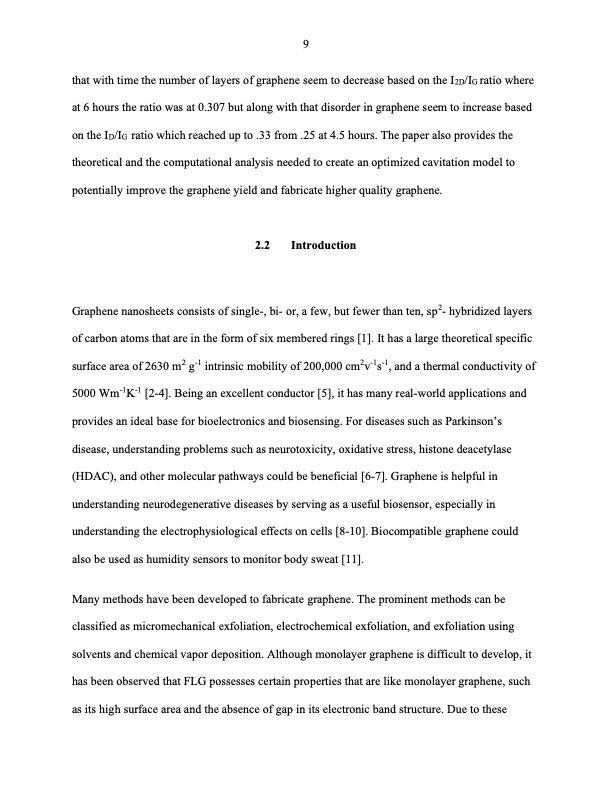PDF Publication Title:
Text from PDF Page: 015
9 that with time the number of layers of graphene seem to decrease based on the I2D/IG ratio where at 6 hours the ratio was at 0.307 but along with that disorder in graphene seem to increase based on the ID/IG ratio which reached up to .33 from .25 at 4.5 hours. The paper also provides the theoretical and the computational analysis needed to create an optimized cavitation model to potentially improve the graphene yield and fabricate higher quality graphene. 2.2 Introduction Graphene nanosheets consists of single-, bi- or, a few, but fewer than ten, sp2- hybridized layers of carbon atoms that are in the form of six membered rings [1]. It has a large theoretical specific surface area of 2630 m2 g-1 intrinsic mobility of 200,000 cm2v-1s-1, and a thermal conductivity of 5000 Wm-1K-1 [2-4]. Being an excellent conductor [5], it has many real-world applications and provides an ideal base for bioelectronics and biosensing. For diseases such as Parkinson’s disease, understanding problems such as neurotoxicity, oxidative stress, histone deacetylase (HDAC), and other molecular pathways could be beneficial [6-7]. Graphene is helpful in understanding neurodegenerative diseases by serving as a useful biosensor, especially in understanding the electrophysiological effects on cells [8-10]. Biocompatible graphene could also be used as humidity sensors to monitor body sweat [11]. Many methods have been developed to fabricate graphene. The prominent methods can be classified as micromechanical exfoliation, electrochemical exfoliation, and exfoliation using solvents and chemical vapor deposition. Although monolayer graphene is difficult to develop, it has been observed that FLG possesses certain properties that are like monolayer graphene, such as its high surface area and the absence of gap in its electronic band structure. Due to thesePDF Image | Hydrodynamic cavitation exfoliation layered graphene nano

PDF Search Title:
Hydrodynamic cavitation exfoliation layered graphene nanoOriginal File Name Searched:
DeAlwis-iastate-0097M-19074.pdfDIY PDF Search: Google It | Yahoo | Bing
Salgenx Redox Flow Battery Technology: Power up your energy storage game with Salgenx Salt Water Battery. With its advanced technology, the flow battery provides reliable, scalable, and sustainable energy storage for utility-scale projects. Upgrade to a Salgenx flow battery today and take control of your energy future.
CONTACT TEL: 608-238-6001 Email: greg@infinityturbine.com (Standard Web Page)